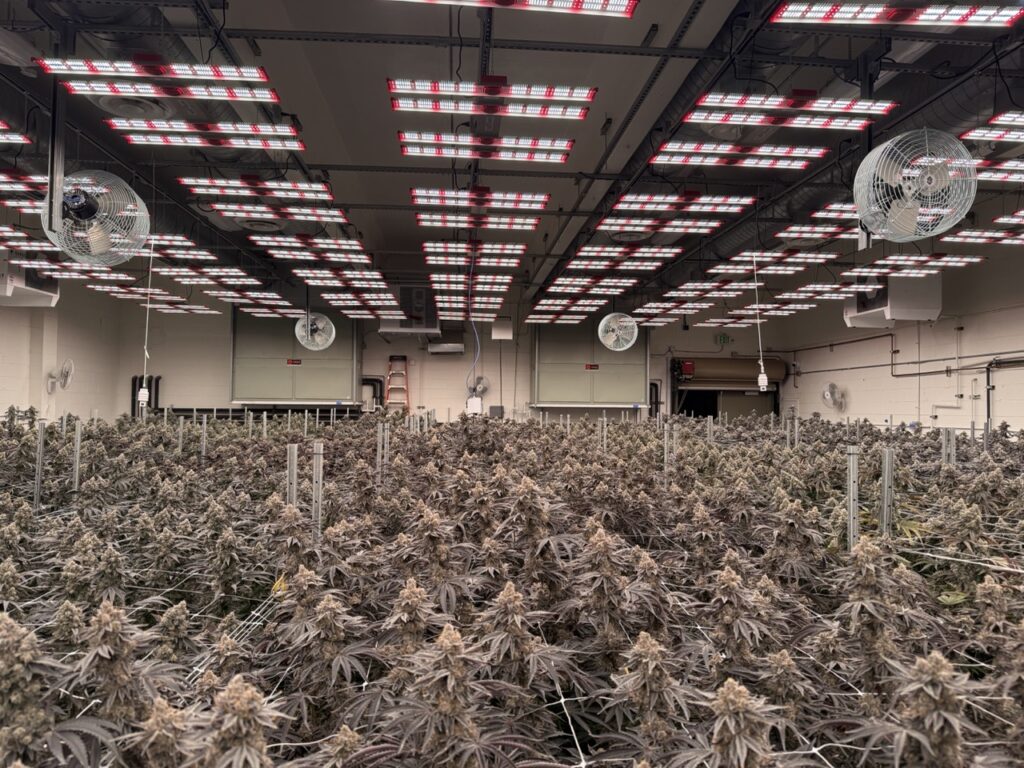
March 5, 2025
Introduction
Cannabis is a high-light crop that thrives under exceptionally high photosynthetic photon flux density (PPFD) and daily light integral (DLI). Multiple studies have demonstrated flower yield increases up to and exceeding DLIs that occur naturally outdoors. While yield increases with light intensity, cannabinoids and terpenes are generally unaffected. The energy usage and electrical costs associated with high light cultivation pose significant economic and environmental challenges for indoor cultivation. This review summarizes findings on yield responses to high light intensity and explores strategies for optimizing energy use while maintaining productivity.
Yield Increases with Light Intensity
Multiple studies have demonstrated a proportional increase in flower yield up to and exceeding full summer sunlight. Llewellyn et al. (2022) reported a linear increase in flower yield at light intensities up to 1000 µmol m-2 s-1 (DLI: 43.2 mol m-2 d-1). Notably, cannabinoid and terpene concentration were largely unaffected by light intensity[1]. Similarly, Rodriguez-Morrison et al. (2021) reported a proportional increase in yield up to 1800 µmol m-2 s-1 (DLI: 77.8 mol m-2 d-1) and minimal effects on cannabinoid and terpene concentration[2].
Sae-Tang et al. (2024) evaluated the response of cannabis to increasing PPFD of 600, 800, and 1000 µmol m-2 s-1. Yield increased proportionally with light intensity, and photon conversion efficiency (PCE) was consistent across treatments at 0.25 g mol-1. In contrast to previous studies, cannabinoid and terpene concentration significantly increased with increased light intensity[3]. This suggests potential genetic variability in secondary metabolite response to light intensity, but further research is needed to draw strong conclusions. Nielson (2024), in an effort to find an upper limit, evaluated intensities up to 2300 µmol m-2 s-1 (DLI 100 mol m-2 d-1). Yield increased almost linearly between a DLI of 43.2 and 100 mol m-2 d-1. Interestingly, cultivar-specific differences in biomass allocation were observed; one cultivar directed more biomass to flowers with increasing light intensity, while one partitioned more biomass into stems, emphasizing the importance of selecting cultivars optimized for high-light environments.
Comparisons with Other Crops
The ability of cannabis to maintain photosynthetic activity and increase biomass at continuous light intensities exceeding 2000 µmol m-2 s-1 distinguishes it from most crops. For example, lettuce and basil typically reach maximum growth between 250 and 600 µmol m-2 s-1, above which minimal increases in yield are observed[4,5]. Wheat, however, has demonstrated a similar yield response to exceptionally high DLIs[6]. Bugbee and Salisbury (1988) reported an increasing wheat yield up to a DLI of 150 mol m-2 d-1. The authors note that the vertical leaf orientation in wheat canopies allows light to penetrate deeper, enhancing photosynthesis throughout the canopy. This contrasts with the predominantly horizontal leaves of cannabis, which restrict light penetration and result in lower photosynthetic capacity in the lower canopy layers. Cultivar selection, strategic canopy management, or redistributing light using under-canopy lighting could improve light distribution within the canopy and increase yield at even higher light intensities.
Energy Use and Economics
Indoor cannabis cultivation is remarkably energy-intensive, with lighting accounting for 38% of energy use and HVAC systems 51%. Lighting demand for cannabis cultivation is at least 70 times more energy intensive than that of commercial office buildings[7].
In 2018, U.S. legal cannabis cultivation consumed 1.1 million MWh, enough to power 92,500 homes. Including illicit operations, total electricity use reached 4.1 million MWh, comparable to Hoover Dam’s annual output. This contributed over 472,000 tons of CO₂ emissions, highlighting the environmental impact of energy use in the cannabis sector[8].
Cost Implications and Market Pressures
Energy is the second-largest cost driver for indoor cannabis cultivation, following labor. Falling wholesale prices nationwide have placed greater emphasis on optimizing energy efficiency to reduce production costs of cannabis. In this competitive market, growers must optimize their operations to reduce costs while maintaining or increasing yields.
Lighting to Maximize Energy Efficiency and Yield
The transition from high-pressure sodium (HPS) lamps to light-emitting diodes (LEDs) offers a promising solution to reduce energy use. Modern LEDs can be 40% or more energy-efficient than HPS. Fixture efficacy describes the amount of photosynthetic light delivered for every Joule of energy input. Broad-spectrum LEDs have efficacies reaching 2.5 to 3.0 µmol J-1 compared to 1.7 µmol J-1 for HPS fixtures[9]. This means that LEDs deliver more light to drive growth and emit less heat than HPS, reducing HVAC loads and enabling vertical cultivation setups that maximize canopy density. Westmoreland et al. (2021) compared yield under traditional HPS lights, with an efficacy of 1.7 µmol J-1, to four broad spectrum LED fixtures that ranged in efficacy from 2.1 to 2.5 µmol J-1. There were small differences in yield per area among treatments, with HPS producing the highest yield. However, yield per dollar of electricity (or per kWh) was 25% higher under a white + red LED fixture with an efficacy of 2.5 µmol J-1 compared to HPS[10]. These findings emphasize the need to consider not yield, but also the energy use and electrical costs associated with indoor cannabis cultivation.

Utility Incentives and Rebate Opportunities
Many utility companies offer rebate programs to support energy-efficient upgrades in cannabis cultivation facilities. These programs provide financial assistance for replacing older lighting systems, such as HPS fixtures, with high-efficacy LEDs. Rebates can significantly offset upfront costs, making advanced technologies more accessible while reducing energy use and operational expenses. Some utilities offer flat rate rebates for light replacements, while others tailor incentives based on energy savings.
These programs help growers achieve long-term cost savings and comply with energy regulations. DDH partners with experts to secure utility rebates, helping you reduce energy use and costs. Contact us to explore how upgrading your lighting system can maximize yields and efficiency.
Conclusion
Cannabis yields increase proportionally with light intensity up to DLIs exceeding full summer sunlight (60 mol m-2 d-1). While such extreme light levels may not be desirable or feasible in a commercial setting, the ability of cannabis to positively respond to high light ‘highlights’ the importance of efficient lighting strategies to maximize yield within practical and economic constraints.
As cannabis cultivation expands nationwide, the growing energy footprint demands a focused effort to adopt lighting technologies that reduce energy use without compromising productivity. High-efficacy LED fixtures and utility rebate programs provide growers tools to lower costs and energy use while maintaining output. The future of cannabis cultivation depends on innovation and efficiency, balancing yield, energy use, and costs for sustainable growth.
References
- Llewellyn, D. et al. Indoor grown cannabis yield increased proportionally with light intensity, but ultraviolet radiation did not affect yield or cannabinoid content. Front Plant Sci 13, 974018 (2022).
- Rodriguez-Morrison, V., Llewellyn, D. & Zheng, Y. Cannabis Yield, Potency, and Leaf Photosynthesis Respond Differently to Increasing Light Levels in an Indoor Environment. Front. Plant Sci. 12, 646020 (2021).
- Sae-Tang, W. et al. High light intensity improves yield of specialized metabolites in medicinal cannabis (Cannabis sativa L.), resulting from both higher inflorescence mass and concentrations of metabolites. Journal of Applied Research on Medicinal and Aromatic Plants 43, 100583 (2024).
- Pennisi, G. et al. Optimal light intensity for sustainable water and energy use in indoor cultivation of lettuce and basil under red and blue LEDs. Scientia Horticulturae 272, 109508 (2020).
- Fu, W., Li, P. & Wu, Y. Effects of different light intensities on chlorophyll fluorescence characteristics and yield in lettuce. Scientia Horticulturae 135, 45–51 (2012).
- Bugbee, B. G. & Salisbury, F. B. Exploring the Limits of Crop Productivity 1. Plant Physiol 88, 869–878 (1988).
- Mills, E. The carbon footprint of indoor Cannabis production. Energy Policy 46, 58–67 (2012).
- Scale Microgrid Solutions & Resource Innovation Institute. The 2018 Cannabis Energy Report. (2018).
- Kusuma, P., Pattison, P. M. & Bugbee, B. From physics to fixtures to food: current and potential LED efficacy. Horticulture Research 7, 1–9 (2020).
- Westmoreland, F. M., Kusuma, P. & Bugbee, B. Cannabis lighting: Decreasing blue photon fraction increases yield but efficacy is more important for cost effective production of cannabinoids. PLoS ONE 16, e0248988 (2021).




